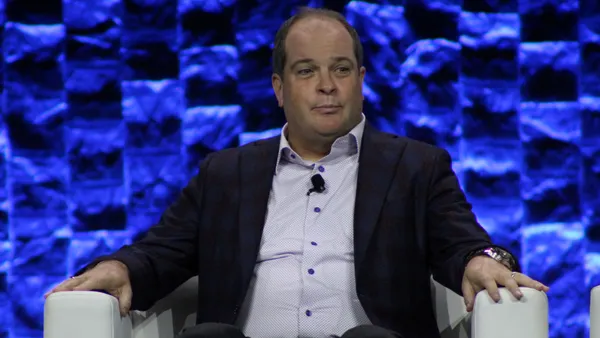Update: July 10, 2019: President Donald Trump signed the kidney care executive order a few minutes before noon Wednesday to launch the initiative, called "Advancing American Kidney Health." This story has been updated to reflect emerging details on HHS proposals and payment models.
Dive Brief:
- President Donald Trump issued a three-pronged executive order Wednesday to revamp the way America treats kidney disease.
- The plan has three aims: reduce the number of Americans with end-stage renal disease by increasing preventive care, incentivize use of home dialysis or kidney transplants to cut down on the use of high-cost dialysis centers and increase the number of organs available for transplant by encouraging the development of artificial and wearable kidneys and modernizing the organ recovery and transplantation system.
- The CMS innovation arm also introduced five new payment models to increase transplants, preventive care and use of at-home dialysis versus in a traditional center. The one mandatory and four voluntary models will be available in Medicare and Medicaid and leverage both upside and downside risk to get kidney care providers to improve quality metrics.
Dive Insight:
The government's goal is to reduce the number of Americans with end-stage renal disease by 25% by 2030, and it aims to upend the traditional way the country pays for kidney care in doing so.
Flanked by patient advocates and regulatory heads, President Donald Trump called fighting kidney disease a "core national priority" in a Wednesday speech. "We are determined to get you the best treatment in the world," he said.
About 37 million Americans — 15% of U.S. adults — suffer from some form of kidney disease, according to the Centers for Disease Control. It was the country's ninth leading cause of death in 2017. Yet, how the U.S. treats kidney disease has remained relatively unchanged since President Ronald Reagan signed the Medicare kidney disease entitlement into law in 1982.
The initiative comes from an administration and Congress bullish on seeking regulatory and legislative fixes to lower healthcare costs. Kidney disease is fertile ground for that push. Medicare spends roughly $114 billion annually on kidney disease — more than 20% of all fee-for-service dollars in the public program.
Renal experts and researchers from organizations such as the Government Accountability Office argue its safer and more cost effective to shift dialysis to home health settings amid a broader shift in site of care from acute facilities to community-based settings.
Every day, about 340 people begin dialysis treatment for kidney failure. But currently, only 12% of Americans receive dialysis treatment in their homes. HHS aims for 80% of Americans receiving dialysis in the home or receiving a viable organ transplant in lieu of in-center dialysis in what HHS Secretary Alex Azar called a "radical change" on a Wednesday morning briefing call.
"In-center dialysis can be more expensive and produce worse outcomes for patients than at-home dialysis or even a kidney transplant,"CMS Administrator Seema Verma told reporters, though the current Medicare system encourages in-center dialysis as the default option for patients beginning treatment.
CMS released more information on the payment models following Trump signing the executive order. The four optional payment models give providers incentives to prevent kidney disease and manage patient health in a more comprehensive, value-based way. CMS expects over 200,000 Medicare patients to enroll in the arrangements, which will run from January 2020 through December 2023.
The required model, called ESRD Treatment Choices, will enroll all U.S. dialysis providers in randomly selected geographic areas spanning half the country and incent them to provide dialysis in the home by adjusted Medicare payments based on home dialysis and transplant rates. CMS will positively adjust payments for the first three years of the model, which will start January 2020 and end June 2026.
All five arrangements will encourage getting eligible patients transplants.
"You should expect these models to be broad and sweeping, impacting half the country," Center for Medicare and Medicaid Innovation head Adam Boehler told reporters.
Shifts in how government reimburses for dialysis will also slam the bottom lines of the largest providers.
Dialysis centers reported roughly $24 billion in revenue in 2018 — most of it netted by just two companies, DaVita and Fresenius Medical Care, that dominate the market with a total of 5,100 clinics. Both companies have invested somewhat in home dialysis recently, with Fresenius taking over home dialysis provider NxStage Medical in February and DaVita saying its dialysis-at-home offerings could eventually increase to 25% of its overall patient population.
Another major player, 233-clinic American Renal Associates, has been lagging in its investments, according to SVB Leerink analysts, and could present treatment growth headwinds for the smaller provider, especially in an increasingly unfriendly regulatory environment.
The push for home dialysis will help CVS Health, which has long planned to offer home dialysis technology. Startups like Somatus and Cricket Health and major payers like UnitedHealth Group, Cigna, Anthem and Humana are in positions to join the push toward home dialysis.
The latest effort also includes doubling down on preventive care, a key tenet of the plan amid the growing prevalence of upstream risk factors like hypertension and diabetes.
"Can we get to these patients sooner, get them slowed and get them into a transplant system?" Azar said.
However, about 40% of people with kidney disease aren't aware they have it until their organs begin to fail. The executive order will include a nationwide awareness campaign about such risk factors before they lead to failure and increase awareness to encourage people to donate their own organs.
HHS also plans to support the development of wearable and implantable kidneys, along with human kidneys for transplantation, in a bid to double the amount available by 2030 and cut down on the some-100,000 Americans waiting for a transplant. HHS will partner with developers, the FDA and through expanding other public-private partnerships like prize competition KidneyX, announced last year, funded by HHS and the American Society of Nephrology.
Additionally, Trump's executive order will call for HHS to improve its monetary support of living donors — those who donate to a family member, a friend or simply into the system will receive financial compensation for lost wages, childcare, transportation and related costs to remove barriers to kidney donation.
Though HHS officials didn't give details on the projected cost of implementing the sweeping executive order, the government expects to save money in Medicare over time, Director of the White House's Domestic Policy Council Joe Grogan said.













